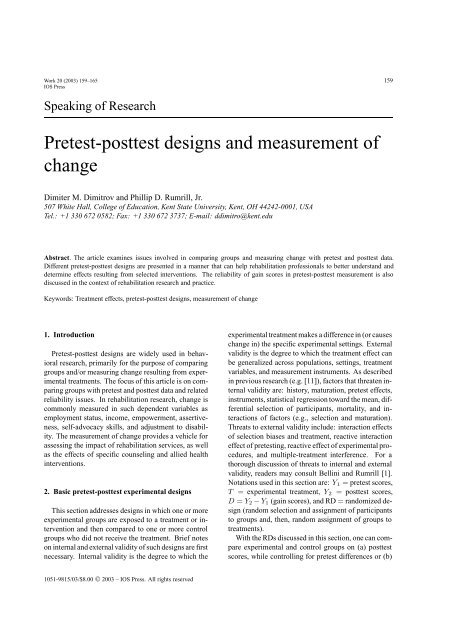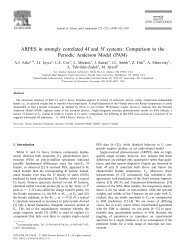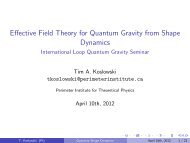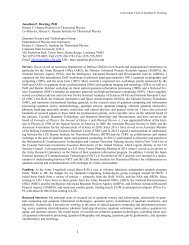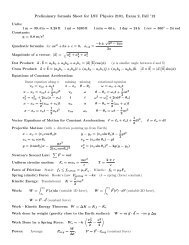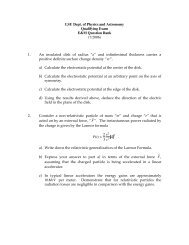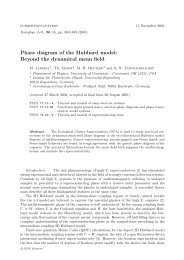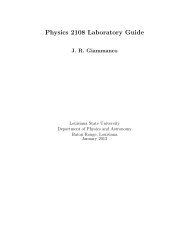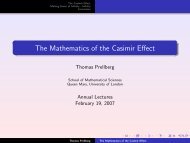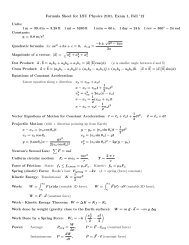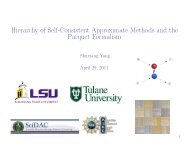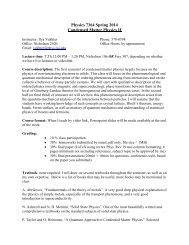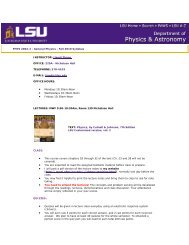Pretest-posttest designs and measurement of change
Pretest-posttest designs and measurement of change
Pretest-posttest designs and measurement of change
Create successful ePaper yourself
Turn your PDF publications into a flip-book with our unique Google optimized e-Paper software.
Work 20 (2003) 159–165 159<br />
IOS Press<br />
Speaking <strong>of</strong> Research<br />
<strong>Pretest</strong>-<strong>posttest</strong> <strong>designs</strong> <strong>and</strong> <strong>measurement</strong> <strong>of</strong><br />
<strong>change</strong><br />
Dimiter M. Dimitrov <strong>and</strong> Phillip D. Rumrill, Jr.<br />
507 White Hall, College <strong>of</strong> Education, Kent State University, Kent, OH 44242-0001, USA<br />
Tel.: +1 330 672 0582; Fax: +1 330 672 3737; E-mail: ddimitro@kent.edu<br />
Abstract. The article examines issues involved in comparing groups <strong>and</strong> measuring <strong>change</strong> with pretest <strong>and</strong> <strong>posttest</strong> data.<br />
Different pretest-<strong>posttest</strong> <strong>designs</strong> are presented in a manner that can help rehabilitation pr<strong>of</strong>essionals to better underst<strong>and</strong> <strong>and</strong><br />
determine effects resulting from selected interventions. The reliability <strong>of</strong> gain scores in pretest-<strong>posttest</strong> <strong>measurement</strong> is also<br />
discussed in the context <strong>of</strong> rehabilitation research <strong>and</strong> practice.<br />
Keywords: Treatment effects, pretest-<strong>posttest</strong> <strong>designs</strong>, <strong>measurement</strong> <strong>of</strong> <strong>change</strong><br />
1. Introduction<br />
<strong>Pretest</strong>-<strong>posttest</strong> <strong>designs</strong> are widely used in behavioral<br />
research, primarily for the purpose <strong>of</strong> comparing<br />
groups <strong>and</strong>/or measuring <strong>change</strong> resulting from experimental<br />
treatments. The focus <strong>of</strong> this article is on comparing<br />
groups with pretest <strong>and</strong> <strong>posttest</strong> data <strong>and</strong> related<br />
reliability issues. In rehabilitation research, <strong>change</strong> is<br />
commonly measured in such dependent variables as<br />
employment status, income, empowerment, assertiveness,<br />
self-advocacy skills, <strong>and</strong> adjustment to disability.<br />
The <strong>measurement</strong> <strong>of</strong> <strong>change</strong> provides a vehicle for<br />
assessing the impact <strong>of</strong> rehabilitation services, as well<br />
as the effects <strong>of</strong> specific counseling <strong>and</strong> allied health<br />
interventions.<br />
2. Basic pretest-<strong>posttest</strong> experimental <strong>designs</strong><br />
This section addresses <strong>designs</strong> in which one or more<br />
experimental groups are exposed to a treatment or intervention<br />
<strong>and</strong> then compared to one or more control<br />
groups who did not receive the treatment. Brief notes<br />
on internal <strong>and</strong> external validity <strong>of</strong> such <strong>designs</strong> are first<br />
necessary. Internal validity is the degree to which the<br />
1051-9815/03/$8.00 © 2003 – IOS Press. All rights reserved<br />
experimental treatment makes a difference in (or causes<br />
<strong>change</strong> in) the specific experimental settings. External<br />
validity is the degree to which the treatment effect can<br />
be generalized across populations, settings, treatment<br />
variables, <strong>and</strong> <strong>measurement</strong> instruments. As described<br />
in previous research (e.g. [11]), factors that threaten internal<br />
validity are: history, maturation, pretest effects,<br />
instruments, statistical regression toward the mean, differential<br />
selection <strong>of</strong> participants, mortality, <strong>and</strong> interactions<br />
<strong>of</strong> factors (e.g., selection <strong>and</strong> maturation).<br />
Threats to external validity include: interaction effects<br />
<strong>of</strong> selection biases <strong>and</strong> treatment, reactive interaction<br />
effect <strong>of</strong> pretesting, reactive effect <strong>of</strong> experimental procedures,<br />
<strong>and</strong> multiple-treatment interference. For a<br />
thorough discussion <strong>of</strong> threats to internal <strong>and</strong> external<br />
validity, readers may consult Bellini <strong>and</strong> Rumrill [1].<br />
Notations used in this section are: Y1 = pretest scores,<br />
T = experimental treatment, Y2 = <strong>posttest</strong> scores,<br />
D = Y2 − Y1 (gain scores), <strong>and</strong> RD = r<strong>and</strong>omized design<br />
(r<strong>and</strong>om selection <strong>and</strong> assignment <strong>of</strong> participants<br />
to groups <strong>and</strong>, then, r<strong>and</strong>om assignment <strong>of</strong> groups to<br />
treatments).<br />
With the RDs discussed in this section, one can compare<br />
experimental <strong>and</strong> control groups on (a) <strong>posttest</strong><br />
scores, while controlling for pretest differences or (b)
160 D.M. Dimitrov <strong>and</strong> P.D. Rumrill, Jr. / <strong>Pretest</strong>-<strong>posttest</strong> <strong>designs</strong> <strong>and</strong> <strong>measurement</strong> <strong>of</strong> <strong>change</strong><br />
mean gain scores, that is, the difference between the<br />
<strong>posttest</strong> mean <strong>and</strong> the pretest mean. Appropriate statistical<br />
methods for such comparisons <strong>and</strong> related <strong>measurement</strong><br />
issues are discussed later in this article.<br />
Design 1: R<strong>and</strong>omized control-group pretest-<strong>posttest</strong><br />
design<br />
With this RD, all conditions are the same for both<br />
the experimental <strong>and</strong> control groups, with the exception<br />
that the experimental group is exposed to a treatment,<br />
T, whereas the control group is not. Maturation<br />
<strong>and</strong> history are major problems for internal validity in<br />
this design, whereas the interaction <strong>of</strong> pretesting <strong>and</strong><br />
treatment is a major threat to external validity. Maturation<br />
occurs when biological <strong>and</strong> psychological characteristics<br />
<strong>of</strong> research participants <strong>change</strong> during the<br />
experiment, thus affecting their <strong>posttest</strong> scores. History<br />
occurs when participants experience an event (external<br />
to the experimental treatment) that affects their<br />
<strong>posttest</strong> scores. Interaction <strong>of</strong> pretesting <strong>and</strong> treatment<br />
comes into play when the pretest sensitizes participants<br />
so that they respond to the treatment differently than<br />
they would with no pretest. For example, participants<br />
in a job seeking skills training program take a pretest<br />
regarding job-seeking behaviors (e.g., how many applications<br />
they have completed in the past month, how<br />
many job interviews attended). Responding to questions<br />
about their job-seeking activities might prompt<br />
participants to initiate or increase those activities, irrespective<br />
<strong>of</strong> the intervention.<br />
Design 2: R<strong>and</strong>omized Solomon four-group design<br />
This RD involves two experimental groups, E1 <strong>and</strong><br />
E2, <strong>and</strong> two control groups, C1 <strong>and</strong> C2. All four groups<br />
complete <strong>posttest</strong> measures, but only groups E 1 <strong>and</strong> C1<br />
complete pretest measures in order to allow for better<br />
control <strong>of</strong> pretesting effects. In general, the Solomon<br />
four-group RD enhances both internal <strong>and</strong> external validity.<br />
This design, unlike other pretest-<strong>posttest</strong> RDs,<br />
also allows the researcher to evaluate separately the<br />
magnitudes <strong>of</strong> effects due to treatment, maturation, history,<br />
<strong>and</strong> pretesting. Let D1, D2, D3, <strong>and</strong> D4 denote<br />
the gain scores for groups E1, C1, E2, <strong>and</strong> C2, respectively.<br />
These gain scores are affected by several factors<br />
(given in parentheses) as follows: D1 (pretesting, treatment,<br />
maturation, history), D2 (pretesting, maturation,<br />
history), D3 (treatment, maturation, history), <strong>and</strong> D 4<br />
(maturation, history). With this, the difference D 3–<br />
D4 evaluates the effect <strong>of</strong> treatment alone, D2–D4 the<br />
effect <strong>of</strong> pretesting alone, <strong>and</strong> D1–D2–D3 the effect<br />
<strong>of</strong> interaction <strong>of</strong> pretesting <strong>and</strong> treatment [11, pp. 68].<br />
Despite the advantages <strong>of</strong> the Solomon four-group RD,<br />
Design 1 is still predominantly used in studies with<br />
pretest-<strong>posttest</strong> data. When the groups are relatively<br />
large, for example, one can r<strong>and</strong>omly split the experimental<br />
group into two groups <strong>and</strong> the control group<br />
into two groups to use the Solomon four-group RD.<br />
However, sample size is almost always an issue in intervention<br />
studies in rehabilitation, which <strong>of</strong>ten leaves<br />
researchers opting for the simpler, more limited twogroup<br />
design.<br />
Design 3: Nonr<strong>and</strong>omized control group<br />
pretest-<strong>posttest</strong> design<br />
This design is similar to Design 1, but the participants<br />
are not r<strong>and</strong>omly assigned to groups. Design<br />
3 has practical advantages over Design 1 <strong>and</strong> Design<br />
2, because it deals with intact groups <strong>and</strong> thus does<br />
not disrupt the existing research setting. This reduces<br />
the reactive effects <strong>of</strong> the experimental procedure <strong>and</strong>,<br />
therefore, improves the external validity <strong>of</strong> the design.<br />
Indeed, conducting a legitimate experiment without the<br />
participants being aware <strong>of</strong> it is possible with intact<br />
groups, but not with r<strong>and</strong>om assignment <strong>of</strong> subjects to<br />
groups. Design 3, however, is more sensitive to internal<br />
validity problems due to interaction between such factors<br />
as selection <strong>and</strong> maturation, selection <strong>and</strong> history,<br />
<strong>and</strong> selection <strong>and</strong> pretesting. For example, a common<br />
quasi-experimental approach in rehabilitation research<br />
is to use time sampling methods whereby the first, say<br />
25 participants receive an intervention <strong>and</strong> the next 25<br />
or so form a control group. The problem with this approach<br />
is that, even if there are <strong>posttest</strong> differences between<br />
groups, those differences may be attributable to<br />
characteristic differences between groups rather than to<br />
the intervention. R<strong>and</strong>om assignment to groups, on the<br />
other h<strong>and</strong>, equalizes groups on existing characteristics<br />
<strong>and</strong>, thereby, isolates the effects <strong>of</strong> the intervention.<br />
3. Statistical methods for analysis <strong>of</strong><br />
pretest-<strong>posttest</strong> data<br />
The following statistical methods are traditionally<br />
used in comparing groups with pretest <strong>and</strong> <strong>posttest</strong> data:<br />
(1) Analysis <strong>of</strong> variance (ANOVA) on the gain scores,<br />
(2) Analysis <strong>of</strong> covariance (ANCOVA), (3) ANOVA on<br />
residual scores, <strong>and</strong> (4) Repeated measures ANOVA.<br />
In all these methods, the use <strong>of</strong> pretest scores helps to<br />
reduce error variance, thus producing more powerful<br />
tests than <strong>designs</strong> with no pretest data [22]. Generally<br />
speaking, the power <strong>of</strong> the test represents the probability<br />
<strong>of</strong> detecting differences between the groups being<br />
compared when such differences exist.
3.1. ANOVA on gain scores<br />
D.M. Dimitrov <strong>and</strong> P.D. Rumrill, Jr. / <strong>Pretest</strong>-<strong>posttest</strong> <strong>designs</strong> <strong>and</strong> <strong>measurement</strong> <strong>of</strong> <strong>change</strong> 161<br />
The gain scores, D = Y2 − Y1, represent the dependent<br />
variable in ANOVA comparisons <strong>of</strong> two or<br />
more groups. The use <strong>of</strong> gain scores in <strong>measurement</strong><br />
<strong>of</strong> <strong>change</strong> has been criticized because <strong>of</strong> the (generally<br />
false) assertion that the difference between scores is<br />
much less reliable than the scores themselves [5,14,15].<br />
This assertion is true only if the pretest scores <strong>and</strong> the<br />
<strong>posttest</strong> scores have equal (or proportional) variances<br />
<strong>and</strong> equal reliability. When this is not the case, which<br />
may happen in many testing situations, the reliability <strong>of</strong><br />
the gain scores is high [18,19,23]. The unreliability <strong>of</strong><br />
the gain score does not preclude valid testing <strong>of</strong> the null<br />
hypothesis <strong>of</strong> zero mean gain score in a population <strong>of</strong><br />
examinees. If the gain score is unreliable, however, it<br />
is not appropriate to correlate the gain score with other<br />
variables in a population <strong>of</strong> examinees [17]. An important<br />
practical implication is that, without ignoring the<br />
caution urged by previous authors, researchers should<br />
not always discard gain scores <strong>and</strong> should be aware <strong>of</strong><br />
situations when gain scores are useful.<br />
3.2. ANCOVA with pretest-<strong>posttest</strong> data<br />
The purpose <strong>of</strong> using the pretest scores as a covariate<br />
in ANCOVA with a pretest-<strong>posttest</strong> design is to (a)<br />
reduce the error variance <strong>and</strong> (b) eliminate systematic<br />
bias. With r<strong>and</strong>omized <strong>designs</strong> (e.g., Designs 1 <strong>and</strong><br />
2), the main purpose <strong>of</strong> ANCOVA is to reduce error<br />
variance, because the r<strong>and</strong>om assignment <strong>of</strong> subjects<br />
to groups guards against systematic bias. With nonr<strong>and</strong>omized<br />
<strong>designs</strong> (e.g., Design 3), the main purpose <strong>of</strong><br />
ANCOVA is to adjust the <strong>posttest</strong> means for differences<br />
among groups on the pretest, because such differences<br />
are likely to occur with intact groups. It is important to<br />
note that when pretest scores are not reliable, the treatment<br />
effects can be seriously biased in nonr<strong>and</strong>omized<br />
<strong>designs</strong>. This is true if <strong>measurement</strong> error is present<br />
on any other covariate in case ANCOVA uses more<br />
than one (i.e., the pretest) covariate. Another problem<br />
with ANCOVA relates to differential growth <strong>of</strong> subjects<br />
in intact or self selected groups on the dependent<br />
variable [3]. <strong>Pretest</strong> differences (systematic bias) between<br />
groups can affect the interpretations <strong>of</strong> <strong>posttest</strong><br />
differences.<br />
Let us remind ourselves that assumptions such as<br />
r<strong>and</strong>omization, linear relationship between pretest <strong>and</strong><br />
<strong>posttest</strong> scores, <strong>and</strong> homogeneity <strong>of</strong> regression slopes<br />
underlie ANCOVA. In an attempt to avoid problems<br />
that could be created by a violation <strong>of</strong> these assump-<br />
tions, some researchers use ANOVA on gain scores<br />
without knowing that the same assumptions are required<br />
for the analysis <strong>of</strong> gain scores. Previous research<br />
[4] has demonstrated that when the regression<br />
slope equals 1, ANCOVA <strong>and</strong> ANOVA on gain scores<br />
produce the same F ratio, with the gain score analysis<br />
being slightly more powerful due to the lost degrees<br />
<strong>of</strong> freedom with the analysis <strong>of</strong> covariance. When the<br />
regression slope does not equal 1, which is usually the<br />
case, ANCOVA will result in a more powerful test.<br />
Another advantage <strong>of</strong> ANCOVA over ANOVA on gain<br />
scores is that when some assumptions do not hold, AN-<br />
COVA allows for modifications leading to appropriate<br />
analysis, whereas the gain score ANOVA does not.<br />
For example, if there is no linear relationship between<br />
pretest <strong>and</strong> <strong>posttest</strong> scores, ANCOVA can be extended<br />
to include a quadratic or cubic component. Or, if the<br />
regression slopes are not equal, ANCOVA can lead into<br />
procedures such as the Johnson-Neyman technique that<br />
provide regions <strong>of</strong> significance [4].<br />
3.3. ANOVA on residual scores<br />
Residual scores represent the difference between observed<br />
<strong>posttest</strong> scores <strong>and</strong> their predicted values from a<br />
simple regression using the pretest scores as a predictor.<br />
An attractive characteristic <strong>of</strong> residual scores is that,unlike<br />
gain scores, they do not correlate with the observed<br />
pretest scores. Also, as Zimmerman <strong>and</strong> Williams [23]<br />
demonstrated, residual scores contain less error than<br />
gain scores when the variance <strong>of</strong> the pretest scores is<br />
larger than the variance <strong>of</strong> <strong>posttest</strong> scores. Compared to<br />
the ANCOVA model, however, the ANOVA on residual<br />
scores is less powerful <strong>and</strong> some authors recommend<br />
that it be avoided. Maxwell, Delaney, <strong>and</strong> Manheimer<br />
[16] warned researchers about a common misconception<br />
that ANOVA on residual scores is the same<br />
as ANCOVA. They demonstrated that: (a) when the<br />
residuals are obtained from the pooled within-group<br />
regression coefficients, ANOVA on residual scores results<br />
in an inflated α-level <strong>of</strong> significance <strong>and</strong> (b) when<br />
the regression coefficient for the total sample <strong>of</strong> all<br />
groups combined is used, ANOVA on residual scores<br />
yields an inappropriately conservative test [16].<br />
3.4. Repeated measures ANOVA with pretest-<strong>posttest</strong><br />
data<br />
Repeated measures ANOVA is used with pretest<strong>posttest</strong><br />
data as a mixed (split-plot) factorial design<br />
with one between-subjects factor (the grouping vari-
162 D.M. Dimitrov <strong>and</strong> P.D. Rumrill, Jr. / <strong>Pretest</strong>-<strong>posttest</strong> <strong>designs</strong> <strong>and</strong> <strong>measurement</strong> <strong>of</strong> <strong>change</strong><br />
Table 1<br />
<strong>Pretest</strong>-<strong>posttest</strong> data for the comparison <strong>of</strong> three groups<br />
Subject Group <strong>Pretest</strong> Posttest Gain<br />
1 1 48 60 12<br />
1 1 70 50 −20<br />
1 1 35 41 6<br />
4 1 41 62 21<br />
5 1 43 32 −11<br />
6 1 39 44 5<br />
7 2 53 71 18<br />
8 2 67 85 18<br />
9 2 84 82 −2<br />
10 2 56 55 −1<br />
11 2 44 62 18<br />
12 2 74 77 3<br />
13 3 80 84 4<br />
14 3 72 80 8<br />
15 3 54 79 25<br />
16 3 66 84 18<br />
17 3 69 66 −3<br />
18 3 67 65 −2<br />
able) <strong>and</strong> one within-subjects (pretest-<strong>posttest</strong>) factor.<br />
Unfortunately,this is not a healthy practice because previous<br />
research [10,12] has demonstrated that the results<br />
provided by repeated measures ANOVA for pretest<strong>posttest</strong><br />
data can be misleading. Specifically, the F test<br />
for the treatment main effect (which is <strong>of</strong> primary interest)<br />
is very conservative because the pretest scores are<br />
not affected by the treatment. A very little known fact<br />
is also that the F statistic for the interaction between the<br />
treatment factor <strong>and</strong> the pretest-<strong>posttest</strong> factor is identical<br />
to the F statistic for the treatment main effect with<br />
a one-way ANOVA on gain scores [10]. Thus, when<br />
using repeated measures ANOVA with pretest-<strong>posttest</strong><br />
data, the interaction F ratio, not the main effect F ratio,<br />
should be used for testing the treatment main effect.<br />
A better practice is to directly use one-way ANOVA<br />
on gain scores or, even better, use ANCOVA with the<br />
pretest scores as a covariate.<br />
Table 1 contain pretest-<strong>posttest</strong> data for the comparison<br />
<strong>of</strong> three groups on the dependent variable Y. Table 2<br />
shows the results from both the ANOVA on gain scores<br />
<strong>and</strong> the repeated measures ANOVA with one between<br />
subjects factor (Group) <strong>and</strong> one within subjects factor,<br />
Time (pretest-<strong>posttest</strong>). As one can see, the F value<br />
with the ANOVA on gain scores is identical to the F<br />
value for the interaction Group x Time with the repeated<br />
measures ANOVA design: F (2, 15) = 0.56, p =0.58.<br />
In fact, using the F value for the between subjects factor,<br />
Group, with the repeated measures ANOVA would<br />
be a (common) mistake: F (2, 15) = 11.34, p =0.001.<br />
This leads in this case to a false rejection <strong>of</strong> the null hypothesis<br />
about differences among the compared groups.<br />
4. Measurement <strong>of</strong> <strong>change</strong> with pretest-<strong>posttest</strong><br />
data<br />
4.1. Classical approach<br />
As noted earlier in this article, the classical approach<br />
<strong>of</strong> using gain scores in measuring <strong>change</strong> has been<br />
criticized for decades [5,14,15] because <strong>of</strong> the (not always<br />
true) assertion that gain scores have low reliability.<br />
Again, this assertion is true only when the pretest<br />
scores <strong>and</strong> the <strong>posttest</strong> scores are equally reliable <strong>and</strong><br />
have equal variances. Therefore, although the reliability<br />
<strong>of</strong> each <strong>of</strong> the pretest scores <strong>and</strong> <strong>posttest</strong> scores<br />
should be a legitimate concern, the reliability <strong>of</strong> the<br />
difference between them should not be thought <strong>of</strong> as<br />
always being low <strong>and</strong> should not preclude using gain<br />
scores in <strong>change</strong> evaluations. Unfortunately, some researchers<br />
still labor under the inertia <strong>of</strong> traditional, yet<br />
inappropriate, generalizations. It should also be noted<br />
that there are other, <strong>and</strong> more serious, problems with the<br />
traditional <strong>measurement</strong> <strong>of</strong> <strong>change</strong> that deserve special<br />
attention.<br />
First, although <strong>measurement</strong> <strong>of</strong> <strong>change</strong> in terms<br />
mean gain scores is appropriate in industrial <strong>and</strong> agricultural<br />
research, its methodological appropriateness<br />
<strong>and</strong> social benefit in behavioral fields is questionable.<br />
Bock [2, pp. 76] noted, “nor is it clear that, for example,<br />
a method yielding a lower mean score in an instructional<br />
experiment is uniformly inferior to its competitor,<br />
even when all <strong>of</strong> the conditions for valid experimentation<br />
are met. It is possible, even likely, that<br />
the method with the lower mean is actually the more<br />
beneficial for some minority <strong>of</strong> students”.<br />
A second, more technical, problem with using rawscore<br />
differences in measuring <strong>change</strong> relates to the<br />
fact that such differences are generally misleading because<br />
they depend on the level <strong>of</strong> difficulty <strong>of</strong> the test<br />
items. This is because the raw scores do not adequately<br />
represent the actual ability that underlies the performance<br />
on a (pre- or post) test. In general, the relationship<br />
between raw scores <strong>and</strong> ability scores is not linear<br />
<strong>and</strong>, therefore, equal (raw) gain scores do not represent<br />
equal <strong>change</strong>s <strong>of</strong> ability. Fischer [7] demonstrated that,<br />
if a low ability person <strong>and</strong> a high ability person have<br />
made the same <strong>change</strong> on a particular ability scale (i.e.,<br />
derived exactly the same benefits from the treatment),<br />
the raw-score differences will misrepresent this fact.<br />
Specifically, with a relatively easy test, the raw-score<br />
differences will (falsely) indicate higher <strong>change</strong> for the<br />
low ability person <strong>and</strong>, conversely, with a more difficult<br />
test, they will (falsely) indicate higher <strong>change</strong> for
D.M. Dimitrov <strong>and</strong> P.D. Rumrill, Jr. / <strong>Pretest</strong>-<strong>posttest</strong> <strong>designs</strong> <strong>and</strong> <strong>measurement</strong> <strong>of</strong> <strong>change</strong> 163<br />
Table 2<br />
ANOVA on gain scores <strong>and</strong> repeated measures ANOVA on demonstration<br />
data<br />
Model/Source <strong>of</strong> variation df F p<br />
ANOVA on gain scores<br />
Between subjects<br />
Group (G) 2 0.56 0.58<br />
S within-group error 15<br />
Repeated measures ANOVA<br />
Between subjects<br />
Group (G) 2 11.34 0.00<br />
S within-group error 15<br />
Time (T)<br />
Within subjects<br />
1 5.04 0.04<br />
T × G 2 0.56 0.58<br />
T × G within-group error 15<br />
Note. The F value for G with the ANOVA on gain score is the same<br />
as the F value for T × G with repeated measures ANOVA.<br />
the high ability person. Indeed, researchers should be<br />
aware <strong>of</strong> limitations <strong>and</strong> pitfalls with using raw-score<br />
differences <strong>and</strong> should rely on dependable theoretical<br />
models for <strong>measurement</strong> <strong>and</strong> evaluation <strong>of</strong> <strong>change</strong>.<br />
4.2. Modern approaches for <strong>measurement</strong> <strong>of</strong> <strong>change</strong><br />
The brief discussion <strong>of</strong> modern approaches for measuring<br />
<strong>change</strong> in this section requires the definition <strong>of</strong><br />
some concepts from classical test theory (CTT) <strong>and</strong><br />
item response theory (IRT). In CTT, each observed<br />
score, X, is a sum <strong>of</strong> a true score, T , <strong>and</strong> an error <strong>of</strong><br />
<strong>measurement</strong>, E (i.e., X = T + E). The true score<br />
is unobservable, because it represents the theoretical<br />
mean <strong>of</strong> all observed scores that an individual may have<br />
under an unlimited number <strong>of</strong> administrations <strong>of</strong> the<br />
same test under the same conditions. The statistical<br />
tests for measuring <strong>change</strong> in true scores from pretest<br />
to <strong>posttest</strong> have important advantages to the classical<br />
raw-score differences in terms <strong>of</strong> accuracy, flexibility,<br />
<strong>and</strong> control <strong>of</strong> error sources. Theoretical frameworks,<br />
<strong>designs</strong>, procedures, <strong>and</strong> s<strong>of</strong>tware for such tests, based<br />
on structural equation modeling, have been developed<br />
<strong>and</strong> successfully used in the last three decades [13,21].<br />
In IRT, the term ability connotes a latent trait that<br />
underlies performance on a test [9]. The ability score<br />
<strong>of</strong> an individual determines the probability for that individual<br />
to answer correctly any test item or perform<br />
a measured task. The units <strong>of</strong> the ability scale, called<br />
logits, typically range from −4 to 4. It is important to<br />
note that item difficulties <strong>and</strong> ability scores are located<br />
on the same (logit) scale. With the one-parameter IRT<br />
model (Rasch model), the probability <strong>of</strong> a correct answer<br />
on any item for a person depends on the difficulty<br />
parameter <strong>of</strong> the item <strong>and</strong> the ability score <strong>of</strong> the person.<br />
Fischer [7] extended the Rasch model to a Linear Logistic<br />
Model for Change (LLMC) for measuring both<br />
individual <strong>and</strong> group <strong>change</strong>s on the logit scale. One <strong>of</strong><br />
the valuable features <strong>of</strong> the LLMC is that it separates<br />
the ability <strong>change</strong> into two parts: (1) treatment effect,<br />
the <strong>change</strong> part due to the experimental treatment, <strong>and</strong><br />
(2) trend effect, the <strong>change</strong> part due to factors such as biological<br />
maturation, cognitive development, <strong>and</strong> other<br />
“natural trends” that have occurred during the pretest to<br />
<strong>posttest</strong> time period. Another important feature <strong>of</strong> the<br />
LLMC is that the two <strong>change</strong> components, treatment<br />
effect <strong>and</strong> trend effect, are represented on a ratio-type<br />
scale. Thus, the ratio <strong>of</strong> any two (treatment or trend)<br />
<strong>change</strong> effects indicates how many times one <strong>of</strong> them<br />
is greater (or smaller) than the other. Such information,<br />
not available with other methods for measuring <strong>change</strong>,<br />
can help researchers in conducting valid interpretations<br />
<strong>of</strong> <strong>change</strong> magnitudes <strong>and</strong> trends, <strong>and</strong> in making subsequent<br />
informed decisions. The LLMC has been applied<br />
in measuring <strong>change</strong> in various pretest-<strong>posttest</strong><br />
situations [6,20]. A user-friendly computer s<strong>of</strong>tware<br />
for the LLCM is also available [8].<br />
5. Conclusion<br />
Important summary points are as follows:<br />
1. The experimental <strong>and</strong> control groups with Designs<br />
1 <strong>and</strong> 2 discussed in the first section <strong>of</strong> this<br />
article are assumed to be equivalent on the pretest<br />
or other variables that may affect their <strong>posttest</strong><br />
scores on the basis <strong>of</strong> r<strong>and</strong>om selection. Both <strong>designs</strong><br />
control well for threats to internal <strong>and</strong> external<br />
validity. Design 2 (Solomon four-group design)<br />
is superior to Design 1 because, along with<br />
controlling for effects <strong>of</strong> history, maturation, <strong>and</strong><br />
pretesting, it allows for evaluation <strong>of</strong> the magnitudes<br />
<strong>of</strong> such effects. With Design 3 (nonr<strong>and</strong>omized<br />
control-group design), the groups being<br />
compared cannot be assumed to be equivalent on<br />
the pretest. Therefore, the data analysis with this<br />
design should use ANCOVA or other appropriate<br />
statistical procedure. An advantage <strong>of</strong> Design<br />
3 over Designs 1 <strong>and</strong> 2 is that it involves intact<br />
groups (i.e., keeps the participants in natural settings),<br />
thus allowing a higher degree <strong>of</strong> external<br />
validity.<br />
2. The discussion <strong>of</strong> statistical methods for analysis<br />
<strong>of</strong> pretest-<strong>posttest</strong> data in this article focuses
164 D.M. Dimitrov <strong>and</strong> P.D. Rumrill, Jr. / <strong>Pretest</strong>-<strong>posttest</strong> <strong>designs</strong> <strong>and</strong> <strong>measurement</strong> <strong>of</strong> <strong>change</strong><br />
on several important facts. First, contrary to the<br />
traditional misconception, the reliability <strong>of</strong> gain<br />
scores is high in many practical situations, particularly<br />
when the pre- <strong>and</strong> <strong>posttest</strong> scores do not<br />
have equal variance <strong>and</strong> equal reliability. Second,<br />
the unreliability <strong>of</strong> gain scores does not preclude<br />
valid testing <strong>of</strong> the null hypothesis related to the<br />
mean gain score in a population <strong>of</strong> examinees. It<br />
is not appropriate, however, to correlate unreliable<br />
gain scores with other variables. Third, AN-<br />
COVA should be the preferred method for analysis<br />
<strong>of</strong> pretest-<strong>posttest</strong> data. ANOVA on gain<br />
scores is also useful, whereas ANOVA on residual<br />
scores <strong>and</strong> repeated measures ANOVA with<br />
pretest-<strong>posttest</strong> data should be avoided. With<br />
r<strong>and</strong>omized <strong>designs</strong> (Designs 1 <strong>and</strong> 2), the purpose<br />
<strong>of</strong> ANCOVA is to reduce error variance,<br />
whereas with nonr<strong>and</strong>omized <strong>designs</strong> (Design 3)<br />
ANCOVA is used to adjust the <strong>posttest</strong> means<br />
for pretest differences among intact groups. If<br />
the pretest scores are not reliable, the treatment<br />
effects can be seriously biased, particularly with<br />
nonr<strong>and</strong>omized <strong>designs</strong>. Another caution with<br />
ANCOVA relates to possible differential growth<br />
on the dependent variable in intact or self-selected<br />
groups.<br />
3. The methodological appropriateness <strong>and</strong> social<br />
benefit <strong>of</strong> measuring <strong>change</strong> in terms <strong>of</strong> mean<br />
gain score is questionable; it is not clear, for<br />
example, that a method yielding a lower mean<br />
gain score in a rehabilitation experiment is uniformly<br />
inferior to the other method(s) involved<br />
in this experiment. Also, the results from using<br />
raw-score differences in measuring <strong>change</strong> are<br />
generally misleading because they depend on the<br />
level <strong>of</strong> difficulty <strong>of</strong> test items. Specifically, for<br />
subjects with equal actual (true score or ability)<br />
<strong>change</strong>, an easy test (a ceiling effect test) will<br />
falsely favor low ability subjects <strong>and</strong>, conversely,<br />
a difficult test (a floor effect test) will falsely favor<br />
high ability subjects. These problems with<br />
raw-score differences are eliminated by using (a)<br />
modern approaches such as structural equation<br />
modeling for measuring true score <strong>change</strong>s or (b)<br />
item response models (e.g., LLMC) for measuring<br />
<strong>change</strong>s in the ability underlying subjects’<br />
performance on a test. Researchers in the field <strong>of</strong><br />
rehabilitation can also benefit from using recently<br />
developed computer s<strong>of</strong>tware with modern theoretical<br />
frameworks <strong>and</strong> procedures for measuring<br />
<strong>change</strong> across two (pretest-pottest) or more time<br />
points.<br />
References<br />
[1] J. Bellini <strong>and</strong> P. Rumrill, Research in rehabilitation counseling,<br />
Springfield, IL: Charles C. Thomas.<br />
[2] R.D. Bock, Basic issues in the <strong>measurement</strong> <strong>of</strong> <strong>change</strong>. in:<br />
Advances in Psychological <strong>and</strong> Educational Measurement,<br />
D.N.M. DeGruijter <strong>and</strong> L.J.Th. Van der Kamp, eds, John Wiley<br />
& Sons, NY, 1976, pp. 75–96.<br />
[3] A.D. Bryk <strong>and</strong> H. I. Weisberg, Use <strong>of</strong> the nonequivalent control<br />
group design when subjects are growing, Psychological<br />
Bulletin 85 (1977), 950–962.<br />
[4] I.S. Cahen <strong>and</strong> R.L. Linn, Regions <strong>of</strong> significant criterion difference<br />
in aptitude- treatment interaction research, American<br />
Educational Research Journal 8 (1971), 521–530.<br />
[5] L.J. Cronbach <strong>and</strong> L. Furby, How should we measure <strong>change</strong><br />
- or should we? Psychological Bulletin 74 (1970), 68–80.<br />
[6] D.M. Dimitrov, S. McGee <strong>and</strong> B. Howard, Changes in students<br />
science ability produced by multimedia learning environments:<br />
Application <strong>of</strong> the Linear Logistic Model for<br />
Change, School Science <strong>and</strong> Mathematics 102(1) (2002), 15–<br />
22.<br />
[7] G.H. Fischer, Some probabilistic models for measuring<br />
<strong>change</strong>, in: Advances in Psychological <strong>and</strong> Educational Measurement,<br />
D.N.M. DeGruijter <strong>and</strong> L.J.Th. Van der Kamp, eds,<br />
John Wiley & Sons, NY, 1976, pp. 97–110.<br />
[8] G.H. Fischer <strong>and</strong> E. Ponocny-Seliger, Structural Rasch modeling,<br />
H<strong>and</strong>book <strong>of</strong> the usage <strong>of</strong> LPCM-WIN 1.0, Progamma,<br />
Netherl<strong>and</strong>s, 1998.<br />
[9] R.K. Hambleton, H. Swaminathan <strong>and</strong> H. J. Rogers, Fundamentals<br />
<strong>of</strong> Item Response Theory, Sage, Newbury Park, CA,<br />
1991.<br />
[10] S.W. Huck <strong>and</strong> R.A. McLean, Using a repeated measures<br />
ANOVA to analyze data from a pretest-<strong>posttest</strong> design: A<br />
potentially confusing task, Psychological Bulletin 82 (1975),<br />
511–518.<br />
[11] S. Isaac <strong>and</strong> W.B. Michael, H<strong>and</strong>book in research <strong>and</strong> evaluation<br />
2nd. ed., EdITS, San Diego, CA, 1981.<br />
[12] E. Jennings, Models for pretest-<strong>posttest</strong> data: repeated measures<br />
ANOVA revisited, Journal <strong>of</strong> Educational Statistics 13<br />
(1988), 273–280.<br />
[13] K.G. Jöreskog <strong>and</strong> D.Sörbom, Statistical models <strong>and</strong> methods<br />
for test-retest situations, in: Advances in Psychological <strong>and</strong><br />
Educational Measurement, D.N.M. DeGruijter <strong>and</strong> L.J.Th.<br />
Van der Kamp, eds, John Wiley & Sons, NY, 1976, pp. 135–<br />
157.<br />
[14] L. Linn <strong>and</strong> J.A. Slindle, The determination <strong>of</strong> the significance<br />
<strong>of</strong> <strong>change</strong> between pre- <strong>and</strong> <strong>posttest</strong>ing periods, Review <strong>of</strong><br />
Educational Research 47 (1977), 121–150.<br />
[15] F.M. Lord, The <strong>measurement</strong> <strong>of</strong> growth, Educational <strong>and</strong> Psychological<br />
Measurement 16 (1956), 421–437.<br />
[16] S. Maxwell, H.D. Delaney <strong>and</strong> J. Manheimer, ANOVA <strong>of</strong><br />
residuals <strong>and</strong> ANCOVA: Correcting an illusion by using model<br />
comparisons <strong>and</strong> graphs, Journal <strong>of</strong> Educational Statistics 95<br />
(1985), 136–147.<br />
[17] G.J. Mellenbergh, A note on simple gain score precision, Applied<br />
Psychological Measurement 23 (1999), 87–89.<br />
[18] J.E. Overall <strong>and</strong> J. A. Woodward, Unreliability <strong>of</strong> difference<br />
scores: A paradox for <strong>measurement</strong> <strong>of</strong> <strong>change</strong>, Psychological<br />
Bulletin 82 (1975), 85–86.<br />
[19] D. Rogosa, D. Br<strong>and</strong>t <strong>and</strong> M. Zimowski, A growth curve approach<br />
to the <strong>measurement</strong> <strong>of</strong> <strong>change</strong>, Psychological Bulletin<br />
92 (1982), 726–748.<br />
[20] I. Rop, The application <strong>of</strong> a linear logistic model describing the<br />
effects <strong>of</strong> preschool education on cognitive growth, in: Some
D.M. Dimitrov <strong>and</strong> P.D. Rumrill, Jr. / <strong>Pretest</strong>-<strong>posttest</strong> <strong>designs</strong> <strong>and</strong> <strong>measurement</strong> <strong>of</strong> <strong>change</strong> 165<br />
mathematical models for social psychology, W.H. Kempf <strong>and</strong><br />
B.H. Repp, eds, Huber, Bern, 1976.<br />
[21] D. Sörbom, A statistical model for the <strong>measurement</strong> <strong>of</strong> <strong>change</strong><br />
in true scores, in: Advances in Psychological <strong>and</strong> Educational<br />
Measurement, D.N.M. DeGruijter <strong>and</strong> L.J.Th. Van der Kamp,<br />
eds, John Wiley & Sons, NY, 1976, pp. 1159–1170.<br />
[22] J. Stevens, Applied multivariate statistics for the social sciences<br />
3rd ed., Lawrence Erlbaum, Mahwah, NJ, 1996.<br />
[23] D.W. Zimmerman <strong>and</strong> R.H. Williams, Gain scores in research<br />
can be highly reliable, Journal <strong>of</strong> Educational Measurement<br />
19 (1982), 149–154.


